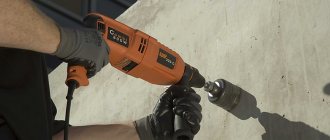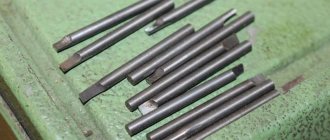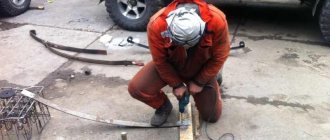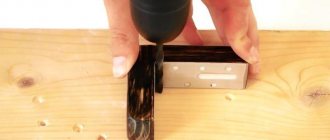In the repair industry, the ability to drill correctly is one of the basic skills. In addition to the general rules, it is important to take into account all the nuances when working with a specific material: concrete, tile, metal, etc. All issues related to drilling will be covered in this article.
- Choosing an electric drill: which one is better?
- How to remove a drill from a hammer drill
General principles of drilling + (Video)
As already mentioned, drilling is the most common activity for a repairman, and therefore it is important to immediately learn a few basic rules associated with this activity.
- Use of suitable tools. There are many drills, each of which is designed for a specific type of material. Therefore, you should not try to drill concrete with a wood drill and vice versa. It is also important to consider the conditions in which the tool will be used. For example, industrial drills cannot be used for interior repairs (this is simply unsafe). It is also important to take into account resistance to moisture: for outdoor work you will need a tool of class IP34 if the climate in the area is humid and IP32 if you have to work in good weather. IPX2/ can be used indoors
- Correct markup. Before starting any work, it is important to carefully and accurately mark the drilling locations with a marker. You can also put paper tape under the marker to prevent the drill from slipping on the material.
- Selecting the required drilling speed. Here everything depends equally on both the material and the diameter of the blade. If we are talking about very thin drills (with a diameter of less than 3 mm), then you need to work at low speeds, less than four hundred per minute. For other drills, the following rule applies: the thinner the drill, the higher the drilling speed required.
It is also important to ensure that the handle is securely attached to the shaft of the hand drill. The drill must also not be allowed to skew.
Which tool and attachment to choose, practical advice
Having understood how to drill concrete, proceed to choosing a tool. The following parameters are key:
- Power.
- Speed regulator (at different stages of drilling one hole, the speed should be different).
- An auxiliary handle on the body (to obtain a straight hole, the drill should not enter the concrete at an acute angle).
- Impact mode (if it is not available, large particles will have to be broken manually with a punch).
- Adjustment of drill installation depth.
In addition, there are:
- Toothed bits of different configurations, made of high-strength alloys for impact drilling.
- KS crowns, the edges of which are covered with diamond chips. They can be used to drill into all hard materials.
- Diamond core bits for hammerless drilling of various diameters and sizes.
For different types of holes, different drills and crowns are chosen. Pobedite bits are cheaper than diamond bits and can be used in impact tools. Diamond drills need to be cooled every 10-15 minutes. Water cannot be used for this.
Subtleties of drilling for various materials
How to drill metal correctly + (Video)
The first thing to start with is the selection of drills. They are distinguished by a sharp edge designed to allow the drill to easily penetrate the metal. Regular metal drills are good for not too hard metals like copper or aluminum, but for something harder (for example, stainless steel) you need to take products made of titanium carbide or chrome-vanadium alloy.
We should also talk about optimal speeds. A common mistake beginners make is using too many turns. In fact, for hard metals, medium speeds are used: for example, brass one centimeter thick will be optimally drilled at a speed of 2000-2500 rpm.
There are a few more points to cover. So:
- If a thin iron plate needs to be drilled, it must be secured between two pieces of wood. This is done so that the sheet of metal does not tear off.
- It is necessary to use lubricating oil from time to time to cool the drill and facilitate the drilling process.
- If you need to make a hole in the pipe, it must be securely fastened. To prevent the pipe from being flattened by the drill, a piece of hard wood should be placed inside.
If you follow these simple rules, then even a beginner will be able to perform high-quality drilling.
How to drill concrete walls + (Video)
In everyday life, you have to drill into walls most often, because without this it is impossible to hang a shelf, a cabinet, or install a cornice. Of course, it is better to use a hammer drill or impact drill for this purpose. These tools are powerful enough to handle hard materials like concrete or brick. However, if the wall thickness does not exceed 10-12 cm, then you can get by with a regular drill. But you shouldn’t take risks if you only have a low-power tool at your disposal - if it comes into contact with concrete, it can simply break. If the drill is selected correctly, then the following tips will be useful:
- Before starting work, you should make sure that there are no pipes or other communication systems in the drilling area.
- The drills used for such work must be made of hard metals or alloys. The best option would be diamond-coated drills.
- If during drilling you come across too dense areas of concrete, they need to be punched out using a small hammer and a pin (punch).
Although it is generally possible to drill through a concrete wall with a drill, it should still be done with caution. Otherwise, the damage can be quite serious. It is better to use specialized tools for this.
How to work with tiles using a drill + (Video)
Often people who do not have extensive experience in the field of repairs are afraid to drill into such a fragile material as tiles. However, this can become an urgent necessity, because you need something to attach various cabinets and shelves in the kitchen, bathroom or toilet. Alas, in many respects the condition of the tile after drilling is determined not by the master who takes up the drill, but by the one who laid the tile. A competent tiler lays the tiles so that no voids form between the tiles and the wall. In this case, careful drilling will not harm the tile in any way. If there are “air pockets” between the wall and the tile, then most likely the tile will crack.
In order to properly drill through the tiles, you need to take a drill, masking tape, or a hammer drill (or a powerful drill with drill bits for concrete). Next you will need to perform the following steps:
- The drilling location is marked with a piece of masking tape and a marker. The tape is here to prevent the nail from sliding on the surface of the tile.
- Drilling is carried out strictly perpendicular to the material. The number of revolutions should increase gradually: from the minimum possible to 150-200 revolutions per minute. This way you can avoid damage to both the material and the tool.
- It is important to ensure that the drill does not overheat. If smoke starts coming out, the drill needs to be cooled down immediately.
Once the holes are made, you can insert dowels into them. This is done with a hammer.
Drilling cast iron - how to do it correctly + (Video)
Cast iron is a fairly hard material, so drilling it is very, very difficult. In addition, cast iron products are fragile, so it is important not to crumble them. Like other materials, cast iron has its own subtleties when it comes to drilling.
- There's no rush. This is perhaps the most important rule when working with cast iron. Everything must be done slowly, with extreme care and attention.
- The drill must be made of a very hard and durable alloy, in addition, it must be perfectly sharpened. To prevent cast iron from crumbling, you need to take drills with an angle of 114-119 degrees.
- It is unacceptable for the drill to overheat. Sometimes they don’t pay attention to the fact that the instrument is overheated. And this can lead to poor quality work or even breakdown.
How to carefully drill through wood + (Video)
Wood is one of the “easiest” materials when working with a drill. However, there are some subtleties here too.
- The drilling speed directly depends on the type of wood. Loose, not too hard types of wood will be suitable even for a low-power device. Of course, the expected diameter of the hole also plays a role - the larger it is, the more powerful the drill is needed.
- In order to make large holes, you need to use special core drills. Their diameter can exceed 120 mm. As for depth, on average crowns are suitable for materials up to 20-22 mm thick, but there are also special models that can cope with thicknesses of more than 60 mm.
- If you need to make a blind hole rather than a through hole, then Forstner drills, which are available in diameters from 1 to 5 cm, are perfect for this.
We should also talk about drilling timber. Although it is convenient to fix it for further drilling, the large thickness of the material creates certain difficulties. Drilling timber for further fastening in the dowel holes. For a standard beam 18 cm thick, it would be best to take a drill with a diameter of 25 mm and a length of 36 cm. You will need to drill slowly, at low speeds. In terms of power, a 1300-1500 W drill is perfect. If the beam is not very long, then two holes on each side will be enough. If the length of the beam for the dowels is long enough, then it will be necessary to make an additional hole in the center. After the holes are made, you can drive the dowels into them using a hammer or small sledgehammer.
Making a homemade device
Devices for drilling wood: a - use of a stop for drilling holes in round workpieces; b - use of a stop for drilling holes in a vertical plane; c - template for drilling the end and plane of the workpiece: 1 - workpiece; 2 - template; 3 - holes in the template; 4 - clamp with which the template is attached.
In practice, drilling a groove at a right angle can be very difficult. Often, many craftsmen use special devices for this. However, these options are often designed for specific types of drilling equipment. Some are suitable for hand drills with slots for additional handles, while others are suitable for cordless ones.
There are also universal options, but they are expensive. People who make furniture cannot do without this device. For a person who makes something on rare occasions, the cost will be quite high.
You can make such an assistant yourself, from the remains of chipboard. The initial blank of such a device looks like bars stuffed on the base of this material.
Here you will later need to drill holes to help the drill find the correct point and angle. A small part of the material is installed end-to-end on the main panel.
Before assembling the device, it is worth making a mark for 3 holes with different sections.
Options for using a guide for drilling.
Take 3 screws, the diameters of which correspond to 5 mm, 6.3 mm and 7 mm. According to these dimensions, grooves are drilled at 3.5 mm, 4 mm and 4.5 mm.
Next, the device is assembled. Holes are drilled for the first holding component, which is immediately secured. Afterwards, a groove is made for another holder. At the time of drilling, a chipboard block is placed between these two parts to create more accurate results for the second element. The device, made independently, must be strong and should not move in all directions.
Such a device will allow you to make grooves only as a drilling device to create a right angle at the end of the panel. To center the drill and drill a hole on a flat base, an additional device is made from this material. To do this, 3 holes with a diameter of 3.5 mm, 4 mm and 4.5 mm are drilled in a chipboard block. Next, marks are fixed on the prepared panels, the drill must pass through the object, and a groove is outlined.
As soon as the markings are made correctly, you need to lower the device onto the panel and place the drill, maintaining a right angle. Now you can drill.
The grooves in the end part are made in the same way. The drill passes through the assistant, the hole is marked, the structure is firmly connected to the side of the manufactured object, after which the drill can be used.
At what speed should you drill?
One of the important parameters when drilling is the number of revolutions per minute. The speed at which you need to drill depends on the type of material and the type of drill. There is a general rule: the harder the material and the thicker the joint, the lower the number of revolutions per minute should be. As for the specific numbers, they can be seen in the table below.
| drill diameter, mm | soft wood | solid wood | plastic (acrylic) | copper | aluminum | steel | Notes |
| 1.5-4.8 | 3000 | 3000 | 2500 | 3000 | 3000 | 3000 | When drilling metal thicker than 3 cm, lubricate the drill thoroughly with oil. |
| 6.4-9.5 | 3000 | 1500 | 2000 | 120 | 2500 | 1000 | |
| 11.1-15.9 | 1500 | 750 | 1500 | 750 | 1500 | 600 | |
| 17.4-25.4 | 750 | 500 | — | 400 | 1000 | 350 |
This table is for conventional twist drills. For specific options (Frostner drill, etc.), the drilling speeds for various materials are slightly different from those given above.
Nozzles: saving effort and money
If we make a rating of power tools for which manufacturers produce additional attachments and accessories, the electric drill is the leader. The drilling tool turns into a multifunctional machine for repair work. She saws, cuts, mills, grinds and does much more. In terms of performance, it will not fully replace every tool, but it solves short-term tasks for a home craftsman.
To operate, the shank of the attachment is clamped in the drill chuck, like a simple drill, and the drilling mode is set.
Sanding and polishing
For grinding, use an attachment for wheels with Velcro, where abrasive wheels of different grain sizes are attached. Metal and wood are polished with cups or discs. In hard-to-reach places, use a fan nozzle.
A file attachment is a pin that is attached at one end to a chuck. On the other it has a solder in the form of a cone, bullet or ball. They are called rollers. The holes are bored and polished using a nozzle. For rough grinding and deburring, rasp attachments are used.
The drill becomes an electric sharpener with special attachments. The sharpening angle is adjustable, you can sharpen anything: drills, chisels, disc blades.
Polishing attachments: soft felt, special for cars, polishing leather ends and others. To work with rotation in any direction, select a speed of 1000 revolutions.
Scissor attachment for drill “Cricket”
With this attachment, the drill becomes a nibbler for thin sheet metal, corrugated sheets and plastic. The shank is attached to the drill chuck. It has two cutting heads that are set at the desired degree. At a rotation speed of 3000 rpm it produces a burr-free cut. You can sharply change the direction of the cut to make shaped parts.
Attachments that make it easier
Corner. Works in hard-to-reach places as a drill and a screwdriver.
Drywall cutters. Used when installing sockets and distribution boxes.
Flexible shaft. One side is attached to the drill chuck, and the drill chuck is on the other end. Drills where a drill cannot cope without such an attachment.
How to drill a hole straight + (Video)
A fairly common problem is that the drill slips off the mark and the hole is not made in the right place. Paper tape glued to the top of the tree can help combat this. Also, sometimes similar difficulties arise if you have to work with an overly thick drill. Then you should first make a recess in the material with a thinner drill, and then drill, resting against the mark you made.
It is important to pay attention to the quality of sharpening. If the edges are not sharp enough or sharpened unevenly, problems with drilling accuracy may occur.
The simplest guide attachment for a drill with your own hands
The nut is removed from the drilling tool. Next, measure its diameter on a plastic bottle and mark it with a felt-tip pen. As a result of these actions, a complete circle should be obtained.
The resulting template, which will need to be cut out later, is marked on the bottle cap so that the width is sufficient.
Next, the bottle or can is trimmed. The template that was previously applied to the bottle and its cap needs to be cut out. Then take the lid and install it into the jar from the front side, achieving maximum fit.
After the glue has dried, a drill is inserted into the nozzle and then used like a plastic nut, fixing it on the tool and starting drilling the hole.
How to drill a perpendicular and vertical hole
Although it is sometimes necessary to drill at an angle, it is most common to make vertical holes (that is, perpendicular to the surface). In order for drilling to take place strictly at an angle of 90 degrees, it is necessary to use special guides. They will allow you to drill perpendicularly without deviating in any direction.
The simplest guides allow you to make only vertical holes, but there are also more complex designs that allow drilling at certain angles.
Drill Guide Features
The drill stand has several important characteristics:
- Vertical stroke (how far the tool can be moved vertically).
- The diameter of the fixing flange (determines what size tool can be clamped).
- Material.
- Size and weight of the device.
Drilling stands can be mobile or stationary. The stationary guides are very reminiscent of a small drill press, they look like a tripod for a drill. Mobile guides are attachments for drilling tools. Their main advantage is their very high mobility.
An important property of the rack is the method of fastening. The most reliable option is a magnetic mount. There is also a simpler option - this is a vacuum mount.
Mobile devices fit comfortably in your hands and absorb vibration when drilling. Most people choose mobile guides. All thanks to their excellent characteristics. They are very reliable, compact and have a low price.
Installation and securing mechanisms
More convenient to use are mechanisms that perform both functions at once - secure and install the workpiece in the desired position. With all this, the part is simply installed in the fixture and clamped. Next comes the welding of the workpieces.
A more common device in design is a device for welding perpendicularly connected products. The device base is mounted on a welding table.
If these are huge products, then a lattice frame is made and placed in a horizontal plane. The products to be welded are placed on its surface at right angles to each other. For this purpose, there are guides in the form of corners on the plane.
If you need to weld one or more products at right angles, you can fix them using screw-shaped clamps (clamps). It is easier to start welding any connections at right angles on a welding table.
When laid on the table, the correct placement of the parts in one plane is guaranteed. A corner rectangular clamp helps maintain a right angle between the parts. The parts are secured in several places by welding, after which the whole product can be rotated as necessary for the subsequent operation.
When welding large products, you need to make rotary clamps. This speeds up installation and removal of the product.
Application of magnets
When welding at home, it is convenient to use magnetic clamps. They are electric and based on permanent magnets. Electromagnets are used more in production. For household needs and small industries, latches with permanent magnets are convenient. They are small-sized, can be installed anywhere, some have a variable angle .
Magnetic squares are more ordinary in design and widespread. It is enough to apply the square to the part to be welded with one plane, and accordingly position the second part in order to obtain reliable fastening at a right angle.
It remains to grab the parts in several places. After which the product is welded one hundred percent. Without tack, magnetic angles will not withstand temperature deformations during welding.
In addition to squares, there are universal magnetic devices. They can fix the welded products in almost all positions.
As an example, you can see the MagTab device. The device has two main planes with magnets. The angle between the planes changes, so the device can be mounted on a cylindrical, flat surface or in any corner.
There are two more planes to which the parts are attached. The planes are placed at right angles and have the ability to move relative to the base. This makes it possible to install the product to be welded in the position required.
READ How to Cut Ceiling Plinths in Corners Video
If you have massive permanent magnets, especially neodymium ones, you can make similar devices without the help of others. When using magnetic fasteners, it is necessary to take into account that they lose their strength under the influence of high temperatures, therefore it is necessary to avoid overheating them.
Devices that help weld parts at an angle
The reliability of iron structures depends on the properties of welding work. Therefore, municipal standards are provided that regulate welding processes.
For example, GOST 23518-79 determines what should be the connections of parts welded in a shielding gas environment, and how to create welding at an acute or obtuse angle. Depending on the gas used, the type of electrode, additive, the requirements for the welding process are established.
To comply with the technology, devices are used that prevent parts from changing their position, making the welder’s work easier. Such devices help maintain a right angle or any other.
With a regular mirror
The mirror method is suitable for any drill. It should only be placed on the material being processed with the reflective part up, and when the drill rests, achieve a perfectly straight line between the reflection and the cutting attachment itself. If there is a deviation during operation, the line at the convergence point will bend.
The method is really very good. The only drawback is that a perfectly even angle is obtained from only one plane. This can be changed by using two mirrors.
There is a combined way to use a corner and mirrors. Mirrors are attached to the two inner walls of the corner, and lines are drawn at an equal distance from the convergence point. This method can be considered the best among the others, since the accuracy of the work done will be very high.
With connecting nut
Precise drilling results can be achieved by using a coupling nut or several regular nuts wrapped with electrical tape. The process of use is very simple: the lotion is placed on the surface of the material being processed and held firmly by hand; Next you need to insert the drill into the hole and start working.
The accuracy of the result is amazing, but there is also a drawback. Unfortunately, with such gadgets it is possible to drill perpendicularly only rarely used diameters: with an M5 nut, you will have to use a 4 mm cutting attachment, and with an M10 - 9 mm. You can get out of this situation by drilling out the threads of the nuts, then the holes will have more common diameters.
All three methods are good in their own way. It all depends on the required angle accuracy, as well as the characteristics of the diameter used. In any case, it is not necessary to purchase an expensive drilling machine for one-time use. It is quite possible to make do with the means at hand that will allow you to get an impressive result.
Source
Pipe connection
Welding work is often used when it is necessary to connect pipelines. With all this, the question often arises of how to weld one pipe to another pipe perpendicularly.
If profile pipes of rectangular or square cross-section are used, then everything is simple. At the junction, in the pipe to which the other will be welded, you need to make a cutout for the cross-section of the product being cut into.
After which they must be installed in a corner clamp and tightened with a screw, or in any other device that ensures a perpendicular connection of the parts. Then tack is done in several places and then everything is boiled all around.
When welding round pipes, everything happens exactly the same. Only additionally, at the end of the welded pipe, a cutout is made with a radius that matches the radius of the main pipe. This provides a good joint, which will allow you to get a high-quality seam.
Adapters are often used to connect plastic pipes at right angles. The part is called angle . It allows you to quickly and easily ensure the accuracy of the angle of rotation.
Sources:
https://demidov-art.ru/raznoe/prisposoblenie-dlya-sverleniya-oTVerstij-pod-uglom-prisposobleniya-pod-shkanty-i-pod-uglom-kak-sdelat-svoimi-rukami.html https://svaring .com/welding/prinadlezhnosti/prisposoblenie-dlja-svarki-pod-prjamym-uglom
Main stages of work
To make the conductor, the master uses a square piece of OSB measuring 23x23 mm.
We draw a diagonal line, dividing the square into two triangles, and cut the workpiece into two parts.
We screw the resulting triangles to the base. The distance between the two sidewalls should be slightly larger than the width of the drill body. Between the sidewalls we install a platform on which the drill will rest.
At the last stage, all that remains is to drill a hole in the base of the jig, and the device is ready. We install it on the board and drill holes.
Everything is shown in detail in the video below. This idea was shared by the author of the YouTube channel Woodrise
.
Source











